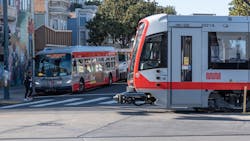San Francisco crowned global winner in 2022 Urban Mobility Readiness Index
San Francisco, Calif., has been ranked the top global city with a mobility ecosystem most prepared to meet the next generation of needs.
The Urban Mobility Readiness (UMR) Index is an annual report from Oliver Wyman Forum and the University of California, Berkeley, that ranks 60 global cities using five dimensions to assess their ability to meet future mobility challenges. The five dimensions include infrastructure, social impact, market attractiveness, system efficiency and innovation.
In addition to the UMR Index, the report includes two sub-indices. The first, Sustainable Mobility, measures the extent to which the city is investing in and driving structural changes in pursuit of cleaner, healthier and more risk-conscious mobility systems. New in the 2022 UMR Index is the Public Transit Sub-Index, which assesses a city’s public transit density, efficiency and utilization rate, and the extent to which the cities can adapt to address competition from emerging mobility services.
“Leading cities in the mobility revolution are likely to expand their public transportation modes, including availability and linkages to provide safe roads, reliable services and employment opportunities, enable emerging technologies like electric and autonomous vehicles, emphasize digitization and sustainability, bolster their risk preparedness and align municipal policies, regulations and budgets accordingly,” the report authors said.
The top North American cities and the UMR Index rankings are as follows:
- San Francisco (1st globally)
- New York City (11th globally)
- Chicago (12th globally)
- Boston (13th globally)
- Washington, D.C. (14th globally)
- Los Angeles (17th globally)
- Vancouver, British Columbia (22nd globally)
- Atlanta (23rd globally)
- Toronto, Ontario (25th globally)
- Montreal (26th globally)
- Houston (27th globally)
- Dallas (28th globally)
“San Francisco takes the top ranking in this year’s Urban Mobility Readiness Index thanks to a rich ecosystem of academia and entrepreneurs who have made the city a global hub for Mobility as a Service and connected autonomous vehicles technologies,” the report authors said. “However, San Francisco does not feature in the top 15 in Sustainable Mobility or Public Transit rankings. The city’s limited number of public transit stations means long walks to reach them and relatively low usage. Despite attempts to mitigate the threat of natural disasters, such as forest fires and earthquakes, San Francisco’s legacy infrastructure means its mobility systems are still inadequately prepared to meet these challenges.”
It wasn’t only San Francisco that failed to crack the top 10 global cities in either of Sustainable Mobility Sub-Index or Public Transit Sub-Index. In the No. 15 slot, Vancouver was the highest ranking North American city in the Sustainable Mobility Sub-Index, followed by Toronto in the No. 19 slot and Dallas in the No. 41 slot with the lowest ranking among North American representatives.
In the Public Transit Sub-Index, Hong Kong, Zurich, Stockholm, Singapore and Helsinki took the top five positions. The top ranking North American city was New York at 13, San Francisco at 16 and Dallas at 45.
“North American cities typically offer strong market attractiveness, usually through a strong university presence and high international airport volumes. However, these cities are sprawling, making it difficult for public transit authorities to provide enough stations. As a result, commuters have long walks to reach transit stations and utilization rate is low. Instead, many residents rely heavily on private car ownership as their primary mode of transport,” the report reads.
On Canadian cities, the report said, “With lower car ownership, stronger public transit systems, and ample car‑free zones, Canadian cities lead on Sustainable Mobility over those in the United States. Cities in the United States often have fewer car‑free zones and underdeveloped micromobility infrastructure, resulting in low rates of active mobility such as walking and cycling.”
About the Author

Mischa Wanek-Libman
Group Editorial Director
Mischa Wanek-Libman is director of communications with Transdev North America. She has more than 20 years of experience working in the transportation industry covering construction projects, engineering challenges, transit and rail operations and best practices.
Wanek-Libman has held top editorial positions at freight rail and public transportation business-to-business publications including as editor-in-chief and editorial director of Mass Transit from 2018-2024. She has been recognized for editorial excellence through her individual work, as well as for collaborative content.
She is an active member of the American Public Transportation Association's Marketing and Communications Committee and served 14 years as a Board Observer on the National Railroad Construction and Maintenance Association (NRC) Board of Directors.
She is a graduate of Drake University in Des Moines, Iowa, where she earned a Bachelor of Arts degree in Journalism and Mass Communication.
